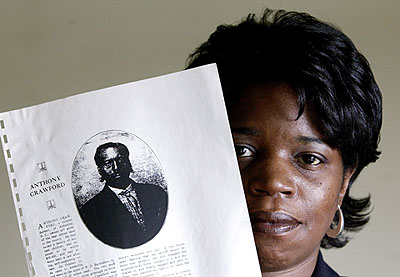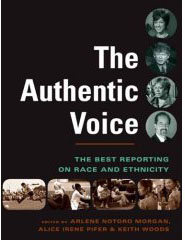Torn from the Land

Doria Dee Johnson holds up a picture of her great-great-grandfather, Anthony P. Crawford, a wealthy black farmer in Abbeville, S.C., who was lynched by a white mob in 1916. His children inherited his 427-acre cotton farm but lost it when they couldn’t pay off a small bank loan. (AP/Photo Kenneth Lambert)
This Associated Press series documents a largely untold chapter of America’s violent racial history. Reporters Dolores Barclay, Todd Lewan and editor Bruce DeSilva teach the importance of investigative reporting by proving the complaints about land thefts that are central to the reparations movement.
The series unequivocally proves specific land ownership claims, thus documenting a history of racial injustice that continues to have human consequences. Barclay and Lewan use a compelling set of facts and interviews to spotlight this particular aspect of being black in America. The story creates a fresh awareness about the history of African Americans and their descendants. The connection of lynching with land grabs is a feature of American history that has garnered scant attention in the history books but reverberates through the economic fabric of African American society.
Part 1 of the series can be found in The Authentic Voice. Read the rest of the series here.
PART II:
Landownership Made Blacks Targets of Violence and Murder
The Associated Press documented 57 violent land takings — more than half of the 107 land takings found in an 18-month investigation of black land loss in America. The other cases involved trickery and legal manipulations.
A Man is Jailed for Defending His Land
George and Mary Dinning were in bed, asleep, when riders came to drive them from their land. By morning, a man lay dead, and George Dinning was on his way to jail. What happened that raw night in January 1897 is told in depositions and trial testimony from Dinning, his wife, Mary, and members of the mob that attacked their tobacco farm.
Taking Away the Vote — and a Black Man’s Land
Robert Gleed was 17 when he escaped from a Virginia slaveowner and trailed his sweetheart to eastern Mississippi. He prospered, owning 295 acres of farmland, three city lots, a stately home and a general store, according to county records. But one violent night in the waning days of Reconstruction, Nov. 1, 1875, Gleed lost it all.
PART III:
Developers and lawyers use a legal maneuver to strip black families of land
Lawyers and real estate traders are stripping Americans of their ancestral land today, simply by following the law. It is done through a court procedure that is intended to help resolve land disputes but is being used to pry land from people who do not want to sell. Black families are especially vulnerable to it.
With Help From Their White Lawyer, a Black Mississippi Family Loses a Farm
Turf Smith had long wanted to carve out 2 acres for himself to build a new house, said two of his children, Quillie and Gene Smith. A white lawyer heard of Smith’s plight — but what happened next, Smith’s children said, was not something he planned or imagined would happen.
AP Graphic: The Lynching Trail
Racial violence in America is a well-told story. But the importance of land as a motive for lynchings has gone largely overlooked. Historians say prosperous blacks – and black landowners – often became targets of white lynch mobs, whose attacks could trigger an exodus of blacks. “If you are looking for stolen black land, just follow the lynching trail.” says Ray Winbush, director of Risk University’s Race Relations Institute.
AP Graphic: A Family Divided
Families that pass down their land without wills or with vague wills are vulnerable to losing their property through a legal procedure known as partitioning. Blacks in the rural South seldom left wills, and experts say thousands of them have lost land through partitioning — land that has been in their families for generations.
For More Information
 Torn from the Land is characterized by strong research, attention to detail, sound historical context, and compelling quotes. Central to the series’ power is the meticulous investigative reporting of AP reporters Dolores Barclay and Todd Lewan and the decision of editor Bruce DeSilva to allow into the stories only cases that could be proven beyond doubt. The story creates a fresh awareness about the history of African Americans and their descendants.
Torn from the Land is characterized by strong research, attention to detail, sound historical context, and compelling quotes. Central to the series’ power is the meticulous investigative reporting of AP reporters Dolores Barclay and Todd Lewan and the decision of editor Bruce DeSilva to allow into the stories only cases that could be proven beyond doubt. The story creates a fresh awareness about the history of African Americans and their descendants.
Teacher’s Guide: Torn from the Land
